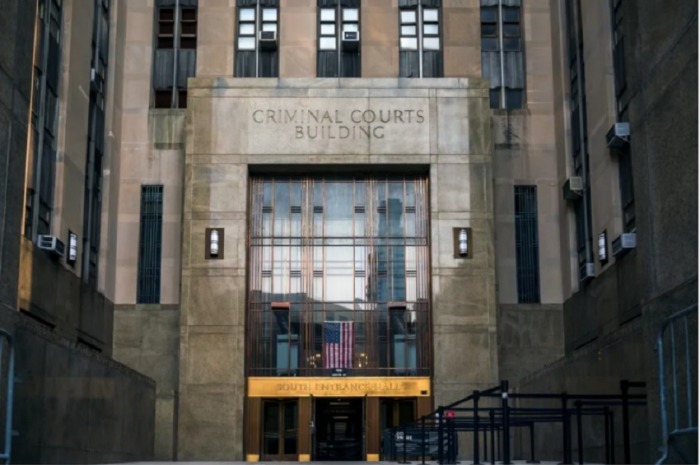
Manhattan Criminal Court in Lower Manhattan, Sept. 14, 2021. Hiram Alejandro Durán/THE CITY

This article was originally published by The CITY on Jan.10
By Greg B. Smith and Suhail Bhat
City Hall expanded supervised release to create an alternative to Rikers Island and ensure defendants show up for trial. The number being rearrested far exceeds projections.
High-flight-risk criminal defendants are being rearrested on felony charges at a much higher rate than city officials projected after being freed without bail under an alternative-to-jail program, newly released state stats show.
Under criminal justice reforms that went into effect in 2020, judges can no longer impose monetary bail against defendants for a vast array of charges. As before, they also cannot factor in whether a defendant is a potential danger to the community.
But for defendants judges consider prone to blow off returning to court, supervised release allows them to be freed pending trial without putting up bail. Instead, they are monitored by social workers to ensure they return to court.
Starting with these programs’ launch in 2016, city officials have insisted that only a small number of supervised release participants were being rearrested on felony charges while on release.
A November 2019 announcement of the program’s expansion by the Mayor’s Office of Criminal Justice (MOCJ) estimated that only 8% had been rearrested for felonies.
But the numbers began to slide: MOCJ listed that rate as 9% in 2018, 10% in 2019, and 13% in 2020, according to annual scorecards on the program the office later released.

But an analysis by THE CITY of data compiled by the state Office of Court Administration and the state Division of Criminal Justice Services reveals a much higher rate more recently: 28% of those freed on supervised release were re-arrested on felony charges from January 2020 through June 2021.
And the data show that participants in supervised release are re-arrested at an even higher rate when misdemeanor rearrests are factored in: 50%.
In all, one out of every two individuals placed in the supervised release program from Jan. 1, 2020 through June 2021 was rearrested after being freed.
That includes 8% rearrested for violent felonies — nearly twice the 5% rate for those released without any restrictions on their own recognizance, according to the data.
Elizabeth Glazer, MOCJ’s former director, was heavily involved in the formation and then expansion of supervised release. Speaking with THE CITY, she acknowledged that the program “was designed for a higher risk population.”
Glazer contends that supervised release defendants are similar to defendants for whom bail is set, estimating that re-arrest rates for both are similar.

Elizabeth Glazer at the announcement of her appointment by Mayor Bill de Blasio in March 2014. Ed Reed for the Office of Mayor
The state data show that re-arrests for violent felonies for both supervised release and bail set defendants were about the same — 8% — but for non-violent felonies, 20% of supervised release defendants were rearrested, compared to 14% for bail set defendants.
Glazer argued that supervised release “was designed to be a middle avenue,” providing judges with a tool to make sure high risk defendants return to court while their cases are pending — without skirting the intent of bail reform.
Defendants freed under supervised release are monitored by social workers and provided with help such as mental health services if they need it. They are also subject to personalized obligations, which could include maintaining employment or school, surrendering passports, and if necessary orders of protection to stay away from an accuser.
“Supervised release was never designed to prevent crime. It was only designed to get people back to court,” she said. “Although it has had a modest effect on reducing crime.”
MOCJ’s scorecards note a return-to-court rate of 87% in 2019 and 2020.
Pandemic Setbacks
In an email to THE CITY, the Vera Institute of Justice, a think tank focused on criminal justice reform, defended the program — theorizing that the increased number of rearrests could be related to havoc caused by the COVID-19 pandemic, which has reduced social worker staff handling these cases.
“Cherry-picking data from a particularly turbulent period, like the recently released OCA data from January 2020-June 2021, will of course skew the results,” wrote Insha Rahman, VP of Advocacy and Partnerships at the Vera Institute of Justice.
“The Supervised Release program was forced to temporarily shut down when the pandemic first emerged and then resumed operations remotely until recently. It is therefore no surprise that the program’s ability to serve people effectively was compromised.”
Rahman stated that of the 40% of supervised release participants who were rearrested within 6 months of their initial arrest, only 6% were rearrested for violent felonies. (Office of Court Administration data states 50% were rearrested, including 8% for violent felonies, during the year and a half period covered by the data.)
And Rahman argued that the risk of rearrest is worth the price of reducing the harm caused by keeping defendants who can’t afford bail in jail pre-trial:
“Data from other jurisdictions that have robust pretrial services programs, like New Jersey, similarly demonstrate that people released pretrial with supports, services, and supervision return to court and remain arrest-free at comparable rates to people who are made to pay bail before being released.
She added, “Supervised release, moreover, minimizes the harms caused by pretrial detention — including lost employment, housing, and child custody — and actually serves public safety more effectively than incarceration in the longer term.”
‘Violent’ Examples
The state data shows pretrial release information for 133,000 arraignments held in New York City courts during the time period, which coincided with the first year and a half of bail reform.
Most of those arraigned during that time — about 70% — were charged with misdemeanors. The other 30% faced felony charges, the data show.
All but a few of those arraigned were freed pending trial, and most of those — on 91,506 arraignments — were not rearrested after release.
But 42,200 were rearrested. THE CITY found that more than half of those rearrests occurred within four months of the defendants being freed, with 5,200 rearrested within weeks of their release.
A little more than half (55%) of those rearrested were charged with felonies — either non-violent (16,050) or violent (7,553).
Bail reform vastly expanded the types of crimes for which judges could not impose monetary bail. Its supporters say bail unfairly burdens those with little means, forcing those who can’t come up with the cash to stay in jail while their case awaits trial.
These new no-bail rules mostly applied to misdemeanor charges but also to a number of lesser felonies. Judges could still impose bail against defendants facing the most serious charges such as murder and armed robbery.
In the first year and a half of bail reform, the vast majority of defendants — 82,000 — were released without bail with no restrictions on their own recognizance. Another 19,000 were released on bail and another 17,000 had their cases disposed of at arraignment.
A small number — 1,000 — were remanded to jail without bail, usually because they were already incarcerated.
During that same time, about 14,000 were placed into supervised release — or what is technically called “nonmonetary release.”
Just before bail reform went into effect, City Hall began allowing defendants charged with violent felonies to participate.
In recent weeks, several defendants charged with what appear to be violent acts have been freed on supervised release.
In December, Darrel Johnson, 21, allegedly attacked two women on the Upper West Side, leaving one with a gash in her head and broken teeth. In November Isus Thompson, 38, allegedly slammed an on-duty police officer in The Bronx, Kyo Sun Lee, in the head with a backpack containing a DVD, a metal safe and a box cutter.
Both men were charged with assault and Thompson was also charged with resisting arrest and weapons possession. In both cases, district attorneys sought and a judge approved supervised release. In both cases, the defendants faced charges that were not bail-eligible.
“It’s Not a Surprise’
The data show that supervised release had the highest rate of re-arrest of any of the categories — 50%, compared to 28% for those released on their own recognizance and 35% for those who posted bail. This applies to defendants initially arrested for both misdemeanors and felonies.
This was particularly true for defendants initially charged with so-called violent felonies, including assault, robbery or larceny, and then freed to supervised release.

Defendants charged with misdemeanor assault who were released on their own recognizance were rearrested at a rate of 22%, while those freed via supervised release were rearrested at a rate of 45%, the data show.
Robbery defendants released on their own recognizance were rearrested at a rate of 37%, while those on supervised release were rearrested at a rate of 50%. Larceny defendants RORd were rearrested at a high rate of 50%, but with supervised release, the rate was even higher — 78%.
Former MOCJ director Glazer acknowledged that a closer look at rearrest data makes clear that defendants accused of certain crimes tend to be at a higher risk for rearrest.
Looking at the broad statistics “hides the huge variations amongst the kinds of crimes and it also hides what may be driving the kinds of crimes.
“It’s not a surprise that it’s low level larceny and low level assaults that are the higher [rearrest] crimes,” she added.
The late-2019 expansion of supervised release in tandem with the start of bail reform led to a rapid increase in the number of participants — from 5,651 in 2019 to 7,120 in 2020.
Glazer emphasized that overall the program works well, striking a balance between fairness and public safety.
“Where do New Yorkers, elected officials — how do they weigh how much harm does jail do versus how much does it reduce crime?” she said. “That’s a very very live question.”
THE CITY is an independent, nonprofit news outlet dedicated to hard-hitting reporting that serves the people of New York.
